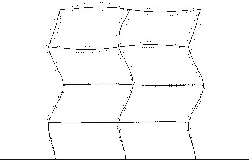
engineering & technology publications
ISSN 1759-3433
PROCEEDINGS OF THE TENTH INTERNATIONAL CONFERENCE ON CIVIL, STRUCTURAL AND ENVIRONMENTAL ENGINEERING COMPUTING
Fuzzy Dynamic Structural Analysis of 2D Frames
+Department of Concrete Bridges and Structures,
*Department of Structural Mechanics
Faculty of Civil Engineering, Czech Technical University, Prague, Czech Republic
For design purposes, one may wish to conduct a statistical analysis, using the statistical characteristics of several measured events. In the case of an earthquake, the measured data for each site of interest is not particularly dense, leaving the statistical characteristics with little relevance. On the other hand, the expected seismic load at a site can be alternatively expressed by the fuzzy sets [1], which take into account the scarcity of seismic stations and the information about local sub-soil composition.
In this paper, an approach to dynamic analysis based on the fuzzy set theory is
presented as an alternative to the classical stochastic dynamic analyses. The material
parameters of reinforced concrete are considered to be fuzzy quantities with a given
distribution, i.e. fuzzy numbers with a desired shape of the membership function [2].
The dynamic analysis is performed with help of the fuzzy arithmetic on either ![]() -cuts
or computation-efficient (L,R) numbers [3]. The result of such an analysis is in the
form of fuzzy numbers which compared with the stochastic approach is less
expensive in terms of computation time and still is provides the designer with an
idea of distribution of the sought quantity. In order to further improve the
computational efficiency, inspired by [4], the concept of a surface response
function [5,6] is utilized.
-cuts
or computation-efficient (L,R) numbers [3]. The result of such an analysis is in the
form of fuzzy numbers which compared with the stochastic approach is less
expensive in terms of computation time and still is provides the designer with an
idea of distribution of the sought quantity. In order to further improve the
computational efficiency, inspired by [4], the concept of a surface response
function [5,6] is utilized.
This approach is demonstrated in an illustrative example of a 2D frame where the
effect of uncertain material parameters transpires in corresponding distributions of
natural modal shapes and natural frequencies of an analysed two-dimensional frame.
The results of the natural vibration analysis can be readily utilized in the
investigation of the response spectrum of a structure. A methodology for a possible
application to seismic design is explained. The question of how many ![]() -cuts are
necessary and how their number influences the result is also tackled.
-cuts are
necessary and how their number influences the result is also tackled.
An example of a mode shape computed with fuzzy numbers is shown in Figure 225.1.
- 1
- Zadeh, L.A., "Fuzzy sets", Information Control, 8 (3), 338-352, 1965. doi:10.1016/S0019-9958(65)90241-X
- 2
- Valliappan, S., Pham, T.D., "Construction the membership function of a fuzzy set with objective and subjective information", Microcomputers in Civil Engrg., 8, 75-82, 1993.
- 3
- Kaufman, A., Gupta, M.M., "Introduction to Fuzzy Arithmetic: Theory and Application", Nostrand Reinhold Company, Inc., New York, 1985.
- 4
- Akpan, U.O., Koko, T.S., Orisamolu, I.R., Gallant, B.K., "Practical fuzzy finite element analysis of structures", Finite Elements in analysis and Design, 38, 93-111, 2001. doi:10.1016/S0168-874X(01)00052-X
- 5
- Bucher, C.G., Chen, Y.M., Schuëler, G.I., "Time Variant Reliability Analysis Utilizing Response Surface Approach", Reliability and Optimization of Structural Systems '88, Eds. P. Thoft-Christensen, 1988.
- 6
- Rajashekhar, M.R., Ellingwood, B.R., "A new look at the response surface approach for reliability analysis", Structural Safety, 12, 205-220, 1993. doi:10.1016/0167-4730(93)90003-J
purchase the full-text of this paper (price £20)
go to the previous paper
go to the next paper
return to the table of contents
return to the book description
purchase this book (price £135 +P&P)
